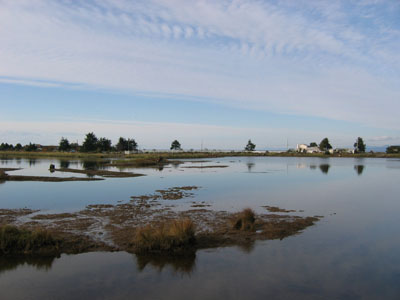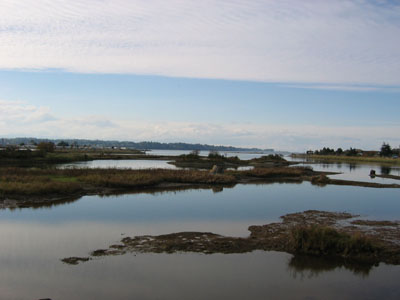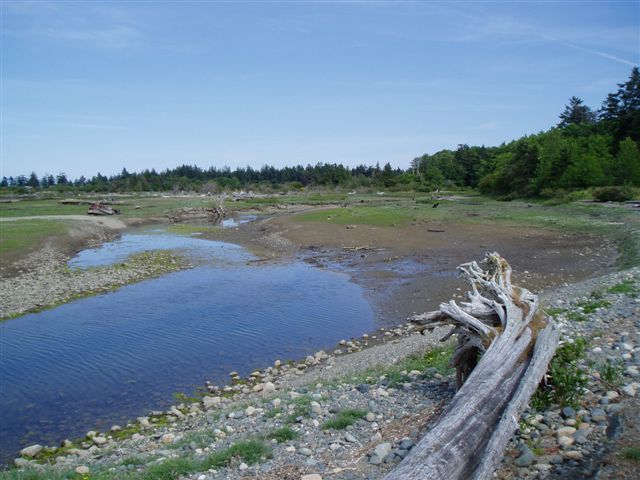Caring for the Englishman River Estuary
This first phase of the Caring for the Englishman Estuary Project has been completed, and you're welcome to share in what we've learned by downloading our final document . MVIHES would like to take this opportunity to thank our sponsors for their support.
Partners in this Project:
Pacific Salmon Foundation, Vancouver Foundation, Georgia Basin Living - Rivers Fund, Environment Canada's EcoAction, Mountain Equipment Co-op, Shell Environmental Fund, Parksville Qualicum Community Foundation, The Nature Trust of BC, Department of Fisheries and Oceans Canada, Ministry of Environment British Columbia, City of Parksville, Regional District of Nanaimo, Seachange Marine Conservation Society, Qualicum Beach and Parksville Streamkeepers, and Arrowsmith Naturalists
 During this phase we conducted an inventory of all plants, birds, fish and wildlife, in the forest, along the river and in the foreshore areas attached to the estuary, and measured water quality and quantity, salinity and toxin levels, and other information to provide us with a picture of the health of our estuary.
During this phase we conducted an inventory of all plants, birds, fish and wildlife, in the forest, along the river and in the foreshore areas attached to the estuary, and measured water quality and quantity, salinity and toxin levels, and other information to provide us with a picture of the health of our estuary.
In addition to the bio-inventory of the Englishman River estuary that we did in 2008, we are in the midst of developing a Volunteer Monitoring Program. If you are interested in becoming a Steward of your Estuary, please read over our program information and Contact Us. We'd love to have you join our team!
The estuary is under considerable pressure from residential development as the population of Parksville grows at a rate higher than the provincial average. Shoreline hardening, invasive plants, pollution from storm water and increased human use are just a few of the impacts changing the dynamics of the system.
 As government funding for monitoring and assessment is increasingly less available, volunteers, directed by professional biologists and working within a well-designed program, can provide the high-quality reliable data that is necessary to maintain this valuable ecosystem.
As government funding for monitoring and assessment is increasingly less available, volunteers, directed by professional biologists and working within a well-designed program, can provide the high-quality reliable data that is necessary to maintain this valuable ecosystem.The volunteer team will measure: water quality including oxygen, nutrients, pH and salinity; biological parameters including wildlife, fish, terrestrial and aquatic vegetation, introduced species; and garbage.
Update: as of 2019 MVIHES volunteers have completed three years of water sampling and beach seining. See our two articles, Beach Seining in the Englishman River Estuary, and Beach Seining in the Englishman River Estuary II.
Gateway to Watershed and Ocean
An estuary is a place where tidal waters from the ocean move up into the river, and river water flows out to the ocean. This mixing of salt and freshwater that changes four times daily with the tide, creates a multitude of habitats that support a wide variety of unique plants, animals, birds, and insects. Plants and animals in an estuary quickly break down and are recycled, resulting in a very high productivity of life. At 145 ha, the estuary is significant to the health of the watershed and to us.
What does the Estuary do for you?
- Serves as a storm buffer, absorbing wave energy and rising tidal waters
- Provides nurseries and other critical habitat for many species of fish, s
 hellfish, birds andother living things that people eat (3/4 of commercial marine fish depend on estuaries at some point in their life cycle).
hellfish, birds andother living things that people eat (3/4 of commercial marine fish depend on estuaries at some point in their life cycle). - Providesopen space for quality of life and recreational experiences
- Provides tourism experiences
- Provides oxygen to us
- Absorbs human wastewater and other pollutants (to a limit)
- Influences high real estate prices
- Provides rich soils and freshwater for some of best farmland
You can help!
You can volunteer as little or as much as you like. Walk in the estuary and count plants, birds, and wildlife.Assist with seasonal activities like beach seining, eelgrass mapping andbird counts, or help to eliminate invasive species such as broom and knapweed. Monitor water quantity and quality, take part in photo-point monitoring, create artwork for use in educational materials, help at community events, or other tasks as needed.
What you can do at home:
- Save water so the groundwater system can refill
- Sign up for the Salmon-Friendly Lawn Program
- Use nature friendly cleaners in your home
- Use compost and natural techniques to fertilize your garden and control pests
- Use mulches to reduce the need to water your garden
- Contribute to local conservation efforts
What you can do at play:
- Get out into your estuary and take a look around
- Enjoy the seasonal differences in the estuary; explore year-round
- Don't trample, or let your pet trample the eelgrass
- Stay on trails and let the natural areas continue to function